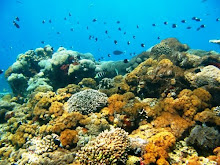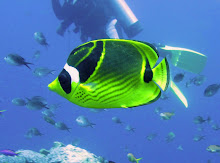by Marthen Welly
The Coral Triangle is known as the global centre of marine biodiversity and one of the world’s top priorities for marine conservation. Indonesia, Malaysia, the Philippines, East Timor, Papua New Guinea and the Solomon Islands are recognised as Coral Triangle countries. The area is home to over 600 reefbuilding coral species, or 75 percent of all species known to science, and more than 3, 000 species of reef fish. The coral triangle covers 5.7 million sq km, equivalent to half the area of the United States.
Within the Coral Triangle, 120 million people depend directly upon coral reefs for food and income, which is the basic reason why The Nature Conservancy (TNC) is working with a range of partners to protect the coastal and marine ecosystems of this vast area by addressing key threats, such as over-fishing, destructive fishing, and mass coral bleaching as a result of global warming.
Marine Protected Areas
TNC is working to transform marine conservation in the Coral Triangle by establishing large-scale networks of marineprotected areas (MPAs) that can survive global change and human threats.
The International Union for Conservation of Nature (IUCN) defines MPAs as: ‘Areas of tidal or subtidal terrain, together with their overlying waters and associated flora, fauna and historical and cultural features, which have been reserved by law or other effective means to protect part or all of the enclosed environment.’ In addition to protecting biodiversity, MPAs provide benefits for commercial fisheries and for nature-based tourism.
A Centre of Excellence
Since 2000, as a centre of excellence on designing and implementing well-managed MPAs within the Coral Triangle, TNC has been developing the Coral Triangle Centre (CTC) in Bali. The CTC will support TNC’s project sites with science, training, policies and financing, while promoting awareness of the need for establishing well-managed marine protected areas.
TNC-CTC is one of the key players in the Coral Triangle Initiative (CTI) that is supported by six coral triangle countries and the USA and Australia. The CTI is led by the Indonesian government under the Ministry of Marine Affairs and Fisheries.
TNC is working on project site conservation in Komodo, Wakatobi, Derawan, Raja Ampat, and the Savu Sea, all in Indonesia; Kimbe Bay in Papua New Guinea; and Arnovan Island of the Solomon Islands. This year, TNC has been expanding to new sites in Nusa Penida and Banda Island in Indonesia, and in East Timor.
Small Island Life
By speedboat from Sanur beach, it takes about 30 minutes to get to the beautiful islands of Nusa Penida, Nusa Lembongan and Nusa Ceningan that lie southeast of Bali. Clear blue water and soft-white sand circling the green islands create a luminous picture that is sure to put you in a relaxed mood, but will also make you want to protect this beautiful paradise.
Nusa Lembongan and Nusa Ceningan are connected by a beautiful 200m yellow bridge that is called the ‘Golden Gate’ of Nusa Penida. In the afternoon, with the golden hues of sunset falling on the marvellous mangrove forest, the fishermen drift on this sensational sea of calm as they take their traditional wooden boats to sea. These islands are rich in Balinese culture. Ped temple on Nusa Penida is one of central temples for the islands, and Balinese from the main island come every year to pray at this temple.
Tourism facilities at Nusa Lembongan are well-developed with marine tourism activities, dive operators, seaview resorts and restaurants easy to find. The prices are reasonable with a wide affordable range. Several of them have good connections with boat cruises from Benoa Harbour on Bali.
Unforgettable Islands
The fresh winds, crystal water, and incredible marine life combined with the friendly people and their Balinese culture will transport you into a different environment, far from the crowded, noisy streets you¡¯ve come from.
You can rent a motorcycle to explore the islands, and by meeting the local people, you will learn how the islanders live with nature. At night, enjoy a fish barbeque with the sounds of the sea as background music and the bright stars glittering in the sky. A romantic candle-light dinner at a beach restaurant is another very attractive option.
Though Nusa Penida is separated from Bali, it is still accessible, easy to reach and offers comfortable facilities.
Nusa Penida Underwater
As part of the coral triangle, Nusa Penida has a complete marine ecosystem with a stunning coral reef, a healthy mangrove forest and a seagrass bed. One visit to Nusa Penida lets you experience a great deal of marine life.
Nusa Penida is one of the best diving sites in Bali and all of Indonesia. Unique and rare marine creatures such as manta rays, stingrays, sea turtles, dolphins and sharks are Penida’s underwater residents. Penida’s most phenomenal underwater creature is the oceanic sunfish - the ‘mola mola’.
The best time to dive at Nusa Penida and see the ‘molamola’ is between August and October. Divers from around the world come to Nusa Penida just to see the ‘mola-mola’, which can grow up to 3.3m in size.
The waters around Nusa Penida are also an important migratory route for Cetaceans in Indonesia. During certain seasons, schools of whales pass through the strait between Bali and Nusa Penida, as well as between Nusa Penida and Lombok. The Dugong has often been spotted off Nusa Lembongan.
As one of the best marine tourism destinations in Bali, Nusa Penida has more than 10 dive sites. Favourite Nusa Penida sites are Blue Corner, Manta Point, SD Ped, Crystal Bay, Segamat, Toyapakeh and Jack Point. Nusa Penida has more than 12sq kms of coral reef and 1/4 sq kms of mangrove forest. These marine ecosystems are vital and important to protect Nusa Penida’s beach as well as fisheries resources and marine tourism assets.
source : http://xlgroupblog.com/the-environment/saving-nusa-penidas-underwater-paradise
Senin, 08 Desember 2008
Langganan:
Posting Komentar (Atom)











Tidak ada komentar:
Posting Komentar